French Macarons (Swiss Meringue Method)
This French Macaron Recipe uses the Swiss Meringue Method and is easy, foolproof and the result of endless testing! In this post, I’ll give you all my tips and tricks, everything I know, to getting macarons that look like they’ve come out of a French patisserie. Chewy on the inside, crispy on the outside and filled with my white chocolate ganache recipe. A true melt in your mouth experience all in one cute little cookie!
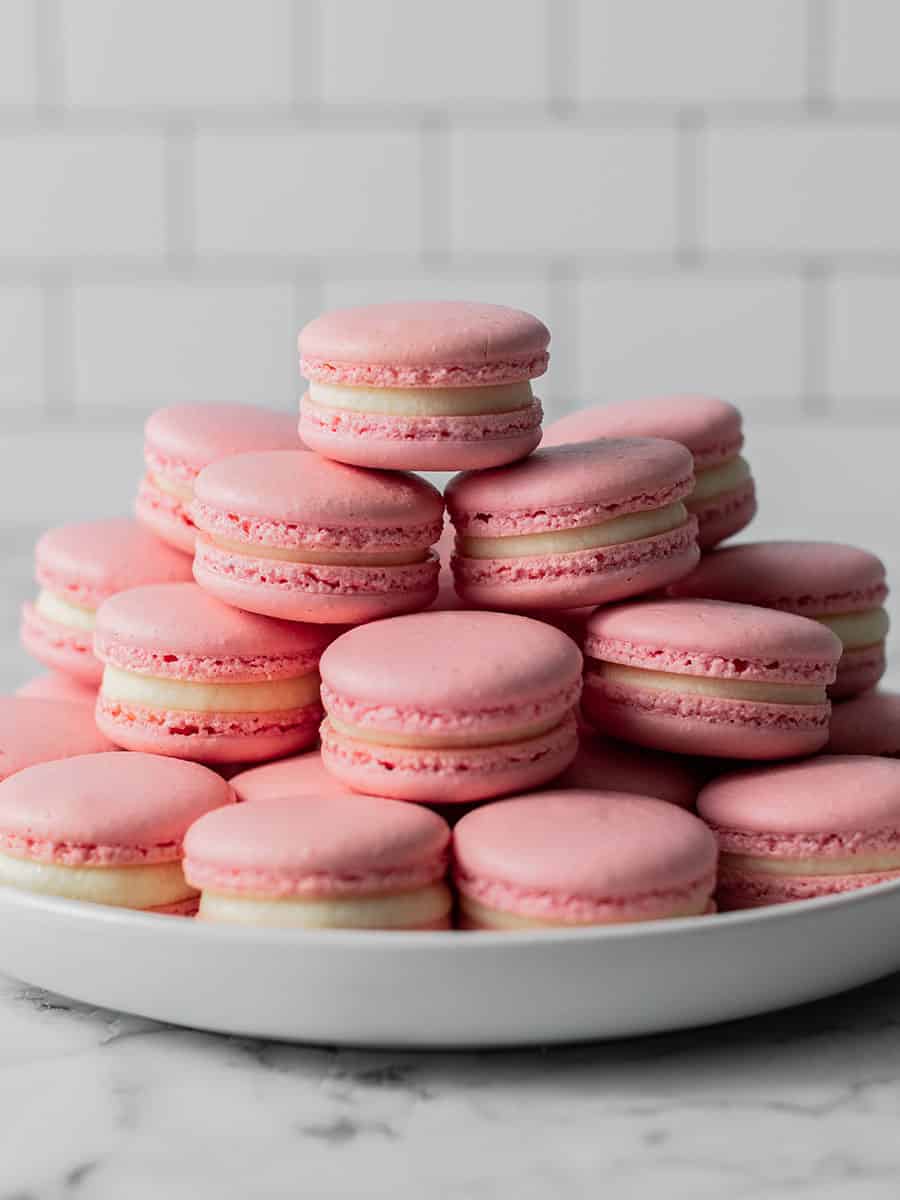
Table of contents
- Macarons vs Macaroons
- What do French Macarons that use the Swiss Meringue Method Taste Like?
- Tools And Equipment You’ll Need.
- Ingredients You Need To Make French Macarons
- How to make French Macarons using the Swiss Meringue Method!
- My favorite fillings!
- Tips and Tricks For Recipe Success!
- Macaron Troubleshooting
- Frequently Asked Questions about French Macarons using the Swiss Meringue Method
If you’ve ever attempted to make these little French cookies, you know they can be finicky, but once you learn the tips and tricks in this blog post, you’ll be onto your way to making amazing macarons! I’ve included my tips and tricks, explanations of the ingredients used, the tools I used and a macaron troubleshooting section too so that you can be equipped for recipe success.


If you’re looking for my popular macaron recipe which has a couple more steps, give my Italian method French Macarons a go. People swear by it. The filling I used in this recipe is my White Chocolate Ganache, but these are great with Chocolate Ganache or even Buttercream!
Macarons vs Macaroons
First off, let me be that person. Yes, some people call this cookie recipe ‘macaroon’. It’s harmless to call it that, but it’s not a macaroon. Macaroons are a coconut cookie made of coconut and egg whites. Really delicious, but completely different from these cookies which are macarons.
Macarons are delicate little French sandwich cookies. That’s what we’ll be making today!
What do French Macarons that use the Swiss Meringue Method Taste Like?
They’re soft and chewy cookies with a thin crisp outside shell. Depending on how you flavor them and fill them, they can pretty much taste however you like! The cookies themselves have a unique almond nougat like flavor with almonds.

Tools And Equipment You’ll Need.
- Kitchen scales – this recipe needs precise measuring and the only way to get that is by measuring your ingredients using digital kitchen scales.
- Mixing bowls – use glass or metal mixing bowls, not plastic. Especially for the meringue.
- Hand whisk – to mix up the egg whites and sugar.
- Electric hand mixer – or stand mixer fitted with balloon whisk attachment.
- Food processor – if you don’t have one of these you can use a fine mesh sieve
- Fine mesh sieve – for sifting almond meal and sugar.
- Spatula – preferably a stiff spatula.
Ingredients You Need To Make French Macarons
Note: the whole recipe, including the ingredient quantities, can be found at the bottom of this page – just scroll down to the bottom, or click the ‘Jump to Recipe’ button at the top of this post.
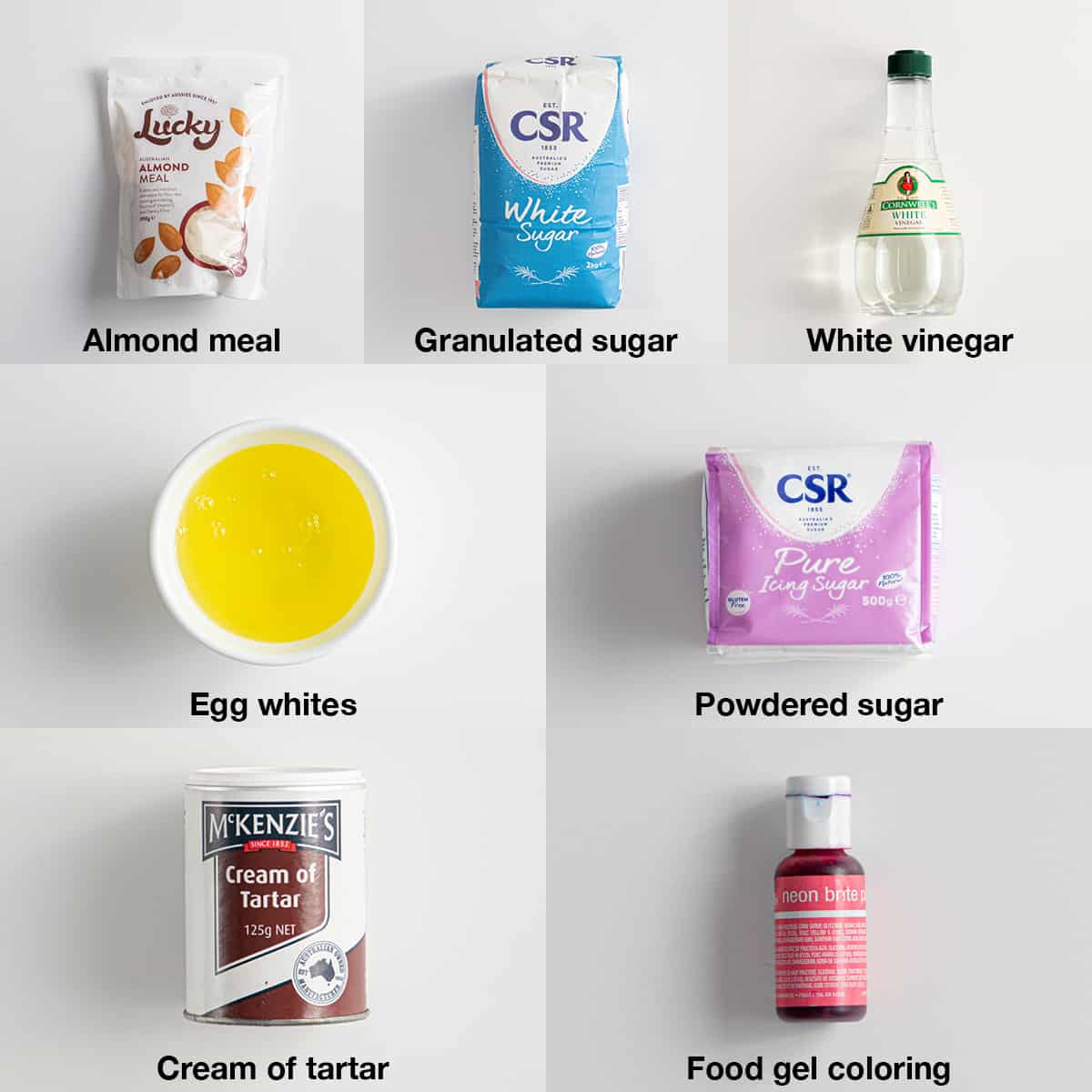
There are several different macaron making methods. Italian, French and Swiss. I’ll be using Swiss method in this recipe. It’s as stable as the Italian method, but in my experience in baking this and testing it 9 times, it’s smoother and shinier which looks nicer.
- White vinegar – this is used to clean the mixing bowl you’ll be using for the macarons.
- Almond flour – you want to use almond flour and not almond meal. Almond meal has the skins left on it before being ground up, almond flour uses blanched almonds which have the skin off and is much finer in texture. That will result in a smoother, shinier and brightly colored macaron. For this recipe you cannot substitute with almond meal with another nut.
- Powdered sugar – you can use pure icing sugar or soft icing sugar which has corn starch added to it. If your sugar is clumpy, run it through a sieve before using.
- Caster sugar – also known as superfine sugar is the best sugar to use as it dissolves quicker than granulated sugar.
- Cream of tartar – this is an acidic powder which helps stabilize the egg whites before being whipped. You can use 1/4 tsp of white vinegar or lemon juice in it’s place.
- Food gel coloring – if you want to color your macaron shells the best thing to do is use food gel, not liquid food dye.
How to make French Macarons using the Swiss Meringue Method!
For an in depth, step-by-step of how to make macarons see the recipe card below and check out my video tutorial.

- Begin by measuring out all of your ingredients – macarons are a quick process and each step doesn’t wait around for you to measure out the ingredients to do the next step.
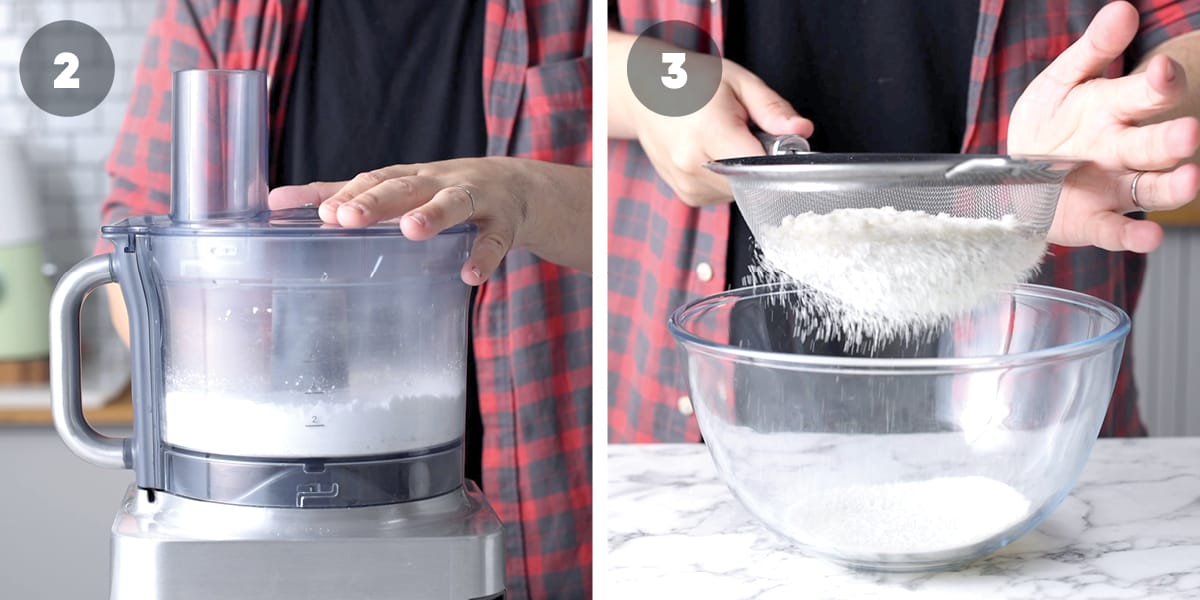
- Blitz the almond meal and powdered sugar together in a food processor.
- Run through a sift.
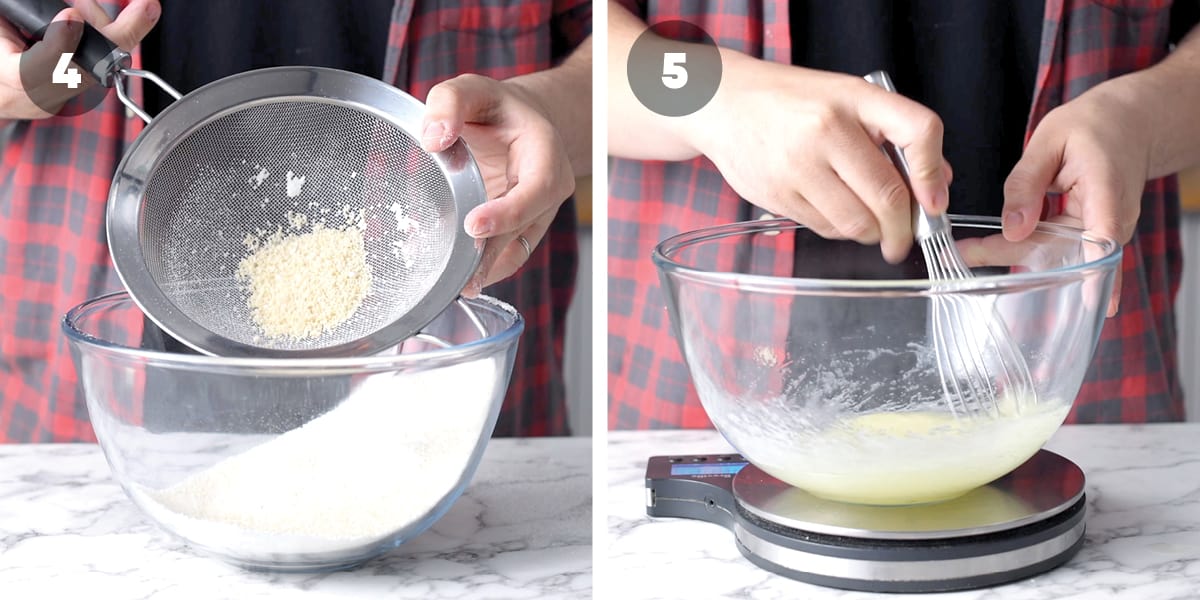
- Discard large pieces of almond meal.
- Whisk egg whites and sugar together
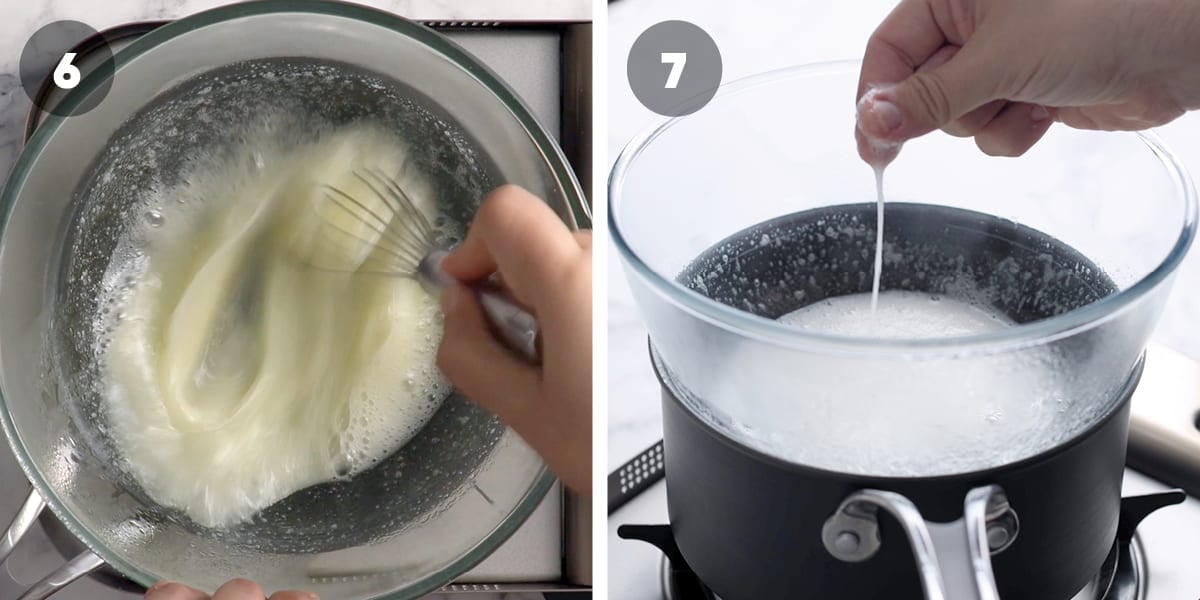
- Place on a double boiler
- Whisk until sugar is dissolved

- Use an electric hand mixer to whip to stiff peaks
- Add dry ingredients
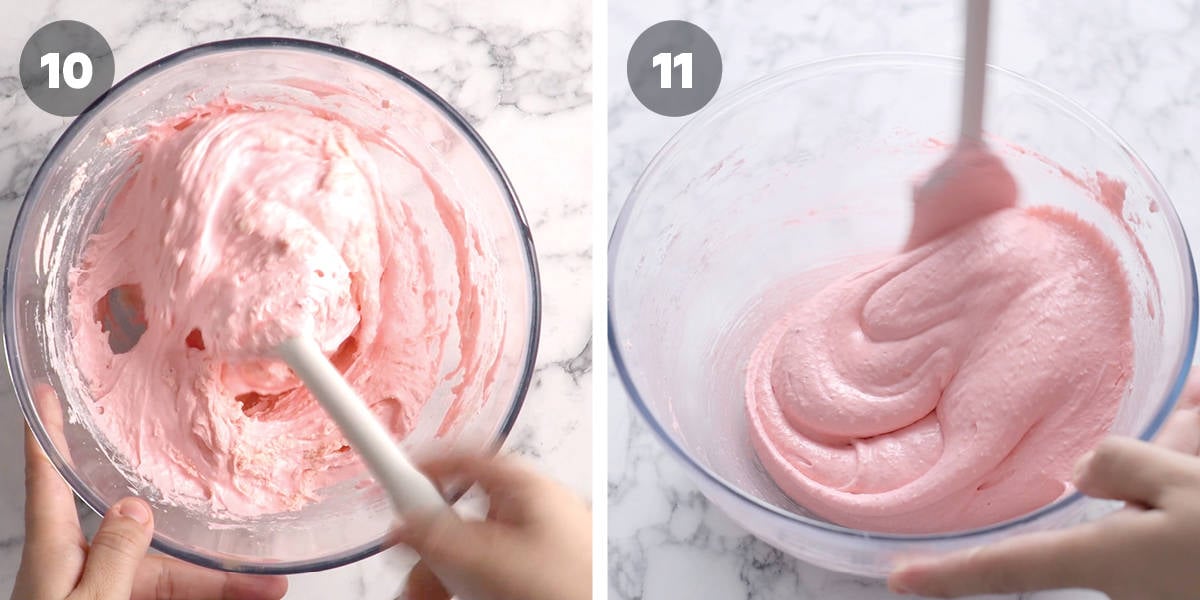
- Mix with a spatula until no dry ingredients are showing
- Then begin mixing by scraping around the bowl
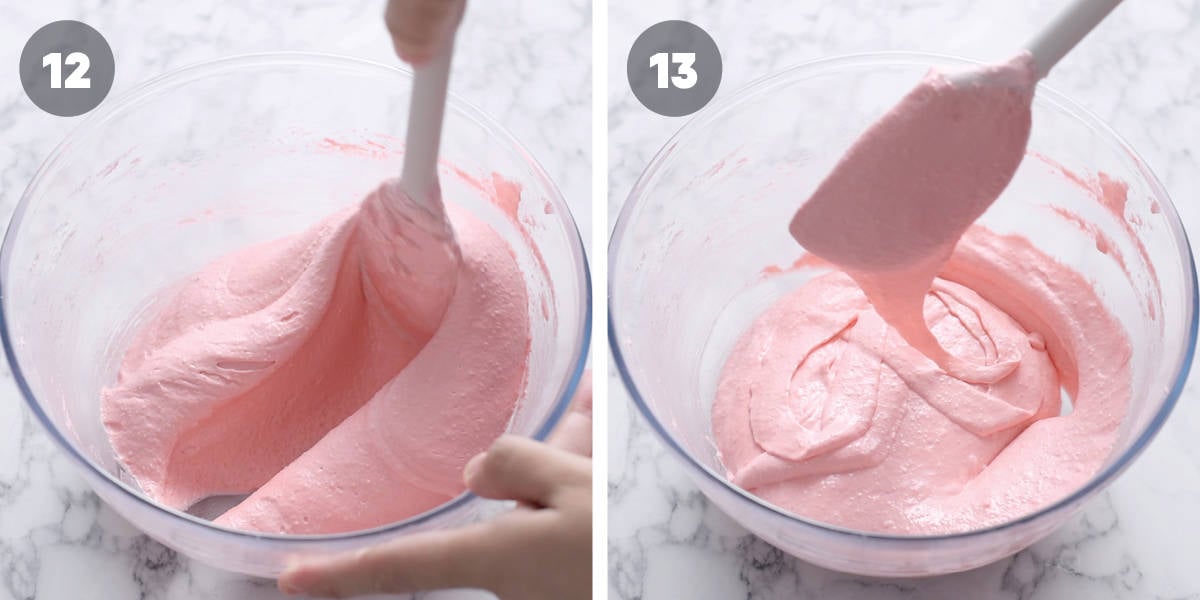
- And through the middle
- When you can get a figure 8, the batter is done
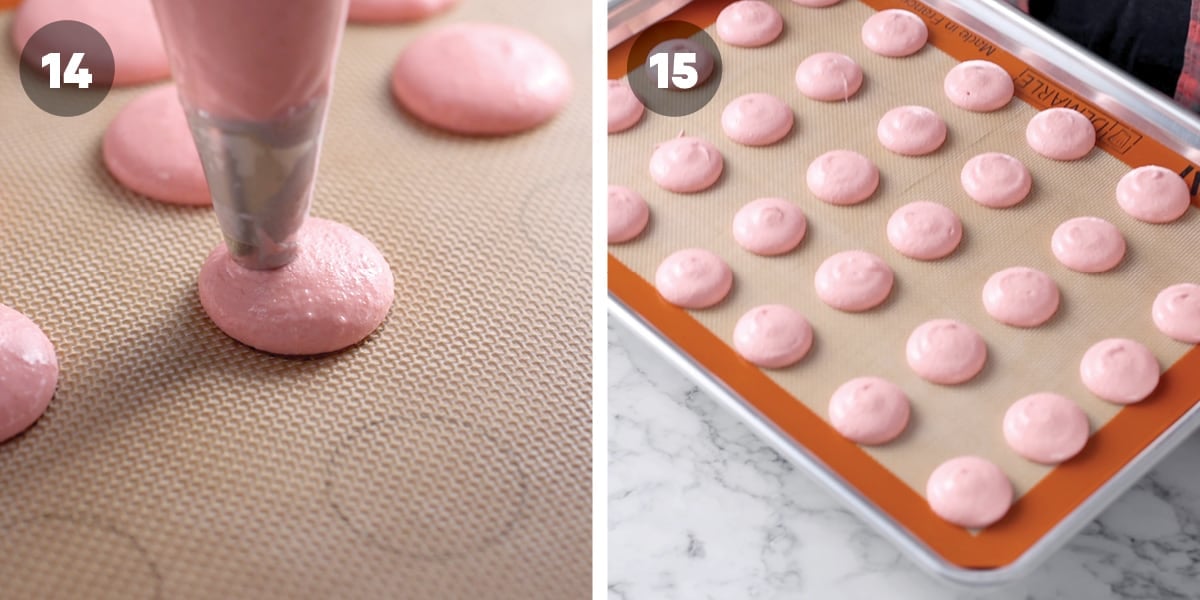
- Pipe macarons
- Tap on bench three times
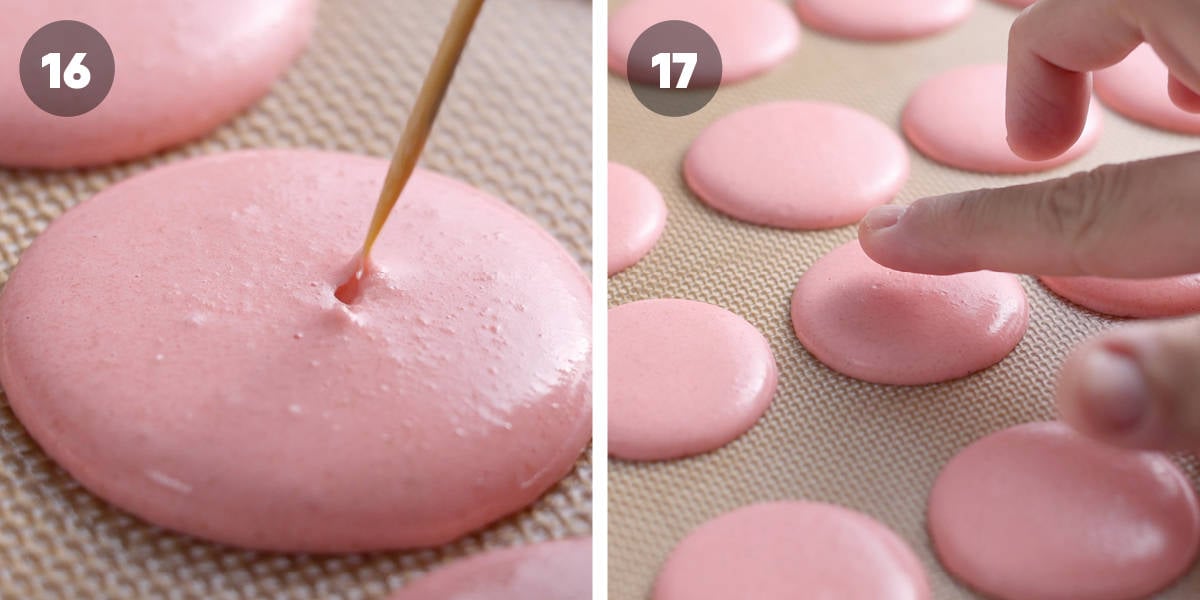
- Pop air bubbles in macarons
- Allow to dry until tops aren’t sticky any more. Then bake in a conventional oven / setting (no-fan), one tray at a time for 10 minutes on 150C / 300F.
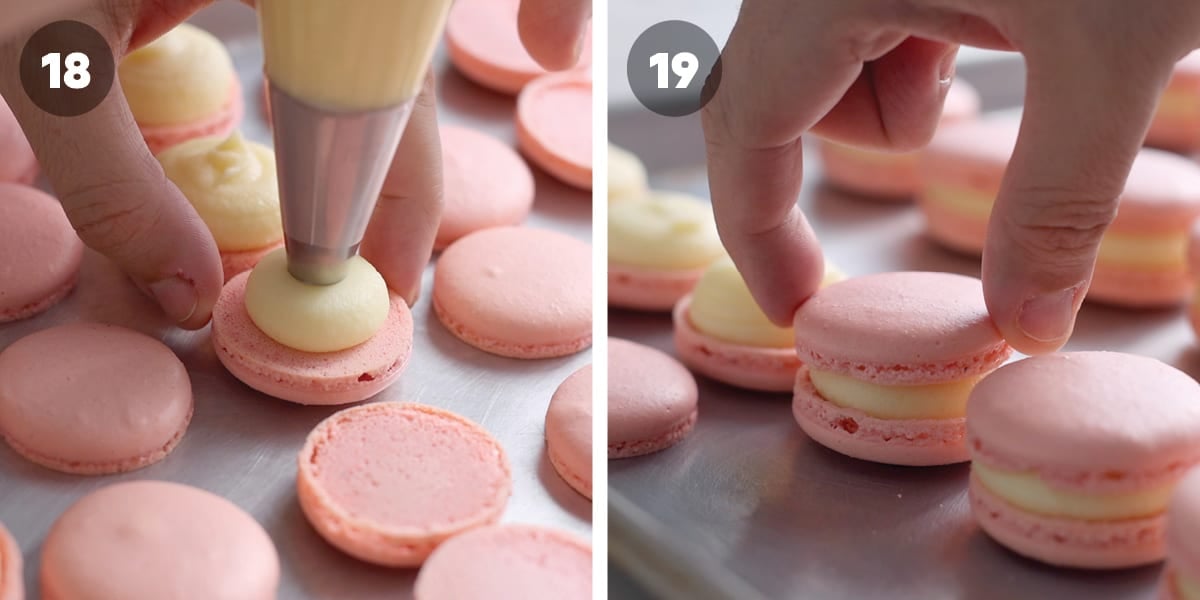
- Fill macarons
- Sandwich them together
My favorite fillings!
You can fill these with anything you like! Flavored frosting, crushed cookie frostings or ganache. Here are my favorite fillings!






- American Buttercream Frosting
- Cream Cheese Frosting
- Chocolate Buttercream Frosting
- Swiss Meringue Buttercream Frosting
- Chocolate Ganache
- White Chocolate Ganache
Tips and Tricks For Recipe Success!
- Clean your meringue mixing bowl using white vinegar.
- Measure your ingredients using kitchen scales and make sure you measure them to the gram! This recipe needs accurate measurements to work and for that reason cup measurements will not work. In fact, in baking all recipes should be measured using kitchen scales for best results.
- If you don’t own a food processor, you can sift the dry ingredients together three times.
- Use good quality almond meal – it’s usually finer. And don’t use almond meal. It has the skins in it.
- If using a food processor, don’t over pulse the ingredients as it can release the oil in the almonds and cause your macarons to crack.
- Take care not to get any egg yolks in the egg whites when separating the eggs.
- To color your macarons – use food gel coloring and not liquid food coloring.
- Use a toothpick to get rid of air bubbles in macarons after they’ve been piped.
- To bake macarons – Bake macarons in the middle rack of your oven, one tray at a time with the fan off.
Macaron Troubleshooting
I’ve been making macarons for over a decade and I’ve learned a thing or two! That’s why I’ve written a complete guide on how to troubleshoot macarons including all my tips and tricks of making these fussy cookies. Any issue or problem you have with macarons, refer to that post. Find the issue you’re having and it will outline why it happened and how to fix it or prevent it from happening again. Highly recommend you check it out if you want to learn as much as you can about this cookie before you begin making them!
Frequently Asked Questions about French Macarons using the Swiss Meringue Method
How to store macarons?
Store macarons in an airtight container for up to three days. They’re even softer and chewier the next day!
How do I know my macarons are baked?
Great question! If they’ve browned, they’re overbaked, if the macarons have risen with nicely formed feet they’re most likely done. If they look done, the best way to test them is to touch them with a finger and if the feet aren’t wiggly and stay put, they’re done.
How do flavor my macarons?
The easiest and best way to flavor macarons is with the filling you choose to use. You can use a ganache or buttercream and fill the center with caramel, Nutella, anything you like! I would avoid adding any oils, extracts or essences to the macarons shells themselves. Disaster awaits if you do!
How do I make chocolate macarons?
Easy! Use the same exact method and ingredients but add 2 tbsp of a good quality cocoa powder to the dry ingredients.
Can macarons be frozen?
Yes! They can can freeze unfilled macarons, thaw them completely and then fill them. Freeze in an airtight container.
If you loved this recipe, check these out!
-
French Macarons (French Method)
-
French Macarons (Italian Method)
-
Highway Unicorn Macarons
-
Hamburger Macarons
A Quick Baking Guide
If you’re new to baking or just want to brush up on the basics, these guides are a great place to start!
Loved the recipe? Let me know!
If you enjoyed this recipe, leave a star rating and comment below. It helps others find the recipe and keeps the baking community growing. Tag me on Instagram so I can see your version too!

French Macarons (Swiss Method)
Serves 30 cookies
Ingredients
Macarons
- 1 tsp white vinegar, to clean bowl
- 120 g almond flour, see notes
- 155 g powdered sugar
- 100 g egg whites, room temperature (see notes)
- 120 g caster sugar, superfine sugar
- 1/4 tsp cream of tartar, or couple drops of vinegar or lemon juice
- 2 drops food gel coloring, optional
Frosting options
- 1/2 batch American buttercream frosting
- 1/2 batch chocolate ganache
- 1/2 batch white chocolate ganache
Learn How To Make it! [VIDEO]
Instructions
Before you begin!
- Measuring ingredients – Measure all ingredients before you begin the recipe.
- Preparing baking trays – Line two half sheet baking trays with silicone baking mats or baking paper (not greaseproof paper). If using baking paper, dab a little macaron batter in the corner of your baking tray to help the baking paper stick to the baking tray. This will prevent it from flying around in the oven.
- Cleaning bowls – Add 1 tsp white vinegar to a glass or metal bowl (not plastic) and wipe down until dry. This is the bowl you will use to make your meringue. This will help your egg whites beat up better and get rid of any fat residue on your bowls.
Macarons
- Almond mixture – Add your almond flour and powdered sugar to the bowl of a food processor and pulse about 10 times to help combine the ingredients and get a finer almond flour. Use a spatula to scrape the bottom of the food processor bowl and pulse another 10 times. Pour into a sieve over a mixing bowl. Sift as much of the mixture as you can. You will have about 2 tbsp of large almond pieces. You can discard them.
- Clean your mixing bowl – Add the vinegar to the bowl you’ll be making your meringue in. Glass or metal, not plastic. And use a paper towel to wipe down. Add the egg whites, sugar and cream of tartar to the bowl and whisk to combine.
- Whisking egg whites and sugar over double boiler – Fill a medium sized pot 1/3 of the way with water and bring to a boil. Place a heatproof bowl on top. Glass or metal, not plastic. Add the egg whites, caster sugar and cream of tartar and whisk until sugar has melted completely and the egg whites become frothy, about 60-90 seconds.
- Whip meringue – Take off the heat and pour into the bowl of a stand mixer fitted with a whisk attachment. Alternatively, you can use an electric hand mixer. If you’re coloring your macarons, add your food gel coloring at this point. Begin whipping on high speed, about 2-3 minutes. The meringue will become thick and glossy and you will reach stiff peaks.
‘Macaronage’ (mixing stage)
- What is it? – This is the most important part of making macarons and can make or break your cookies. The key is not to overmix your batter. Follow the instructions carefully and see the post for step-by-step instructions.
- First mix – Add a spatula full of meringue to the almond mixture and use a spatula to mix until well combined. You don’t need to be too careful how you mix at this stage, this just helps thin out the batter a little.
- How to mix – Add the remaining meringue to the almond mixture. Use your spatula to scrape around the bowl, then go through the middle of the mixture. I’ve left photo instructions in the post of this recipe. Repeat this until you reach the right consistency. This form of mixing helps incorporate the meringue into the almond mixture and also helps slightly deflate the meringue to the right consistency.
- The right consistency – I call it the ‘ribbon stage’. It’s when the batter falls off your spatula, back into the mixture in a thick ribbon. It should disappear back into the batter after about 10 seconds. When you feel like you’re nearing this consistency, begin testing the batter for the ribbon stage. If it’s still too thick, mix another couple times and test again. If the mixture appears thinner than what’s described, there’s no saving it. Start again.
- Transfer batter to piping bag – Fit the end of a large piping bag with a medium sized round tip. I used a 1.5cm / 1/2-inch round tip. Fill half way with batter and then twist the end while the piping tip is facing up.
- Piping your Macarons – Pipe rounds of batter on your baking trays measuring about 3cm / 1 1/4 inch wide and about 2cm / 3/4 inch apart. Gently tap the tray on your workbench three times to allow any air bubbles to rise to the top and escape. If you see little bubbles on top of your piped macarons, use a toothpick to gently deflate them. This will help achieve a smooth macaron cookie.
- Drying your macarons – Allow your macarons to dry for 20-25 minutes out in the open. This will help them form a skin which will help the steam in the cookies escape from the bottom instead of the top giving them their iconic ‘feet’. To test if they are dry enough, run your finger on the top of a macarons, it shouldn’t be sticky anymore. Drying time can be impacted by the humidity and temperature of your oven so it may take longer than 25 minutes to dry. If they’re still sticky, let them continue drying.
- Baking your macarons – While your macarons are drying, preheat a conventional oven (no fan) to 150C / 302F. Bake your macarons 1 tray at a time on the middle rack of your oven for 10-12 minutes. Once they’re baked, let them cool completely before you try to remove them from the tray.
To Finish Macarons
- Once the macarons are baked, pair them up so they all have a size match. Not all the macarons will be the same size. So pairing them up will help them look neat and uniform.
- Pipe filling on half the macarons and sandwich with the other halves. For filling options see the ingredients list.
Notes
- To blanch your almonds – Place your almonds with skin on in a large heatproof bowl and cover with boiling water. Allow to sit for 60 seconds. Drain and rinse with cold water to cool them down. Squeeze each almond and it will slip out of the skin. Discard the skin, keep the almonds! Lay out on a baking tray and allow to dry completely before proceeding to the next step. If you’re using almonds that are already blanched, skip this step and do the next step!
- To blitz the almonds – place the blanched almonds into the bowl of a food processor. Blitz on high speed for 10 – 15 seconds. Stop the mixer and scrape down the bowl. Repeat this process until a fine powdery substance forms. IMPORTANT: Do not over mix. This can cause the mixture to become a paste. If this happens, start again. Overmixing can also cause the almonds to heat in the food processor which releases their natural oils. This can cause problems down the line when making your macarons.

20 comments
What if I only have an oven with a fan (it’s an older commercial convection oven and the fan doesn’t turn off)? Is there a work around? Thank you!
Hi Rori, great question! Commercial convection ovens can be tricky for macarons since the constant fan can cause uneven rising or lopsided shells. If the fan speed isn’t adjustable, try lowering the temperature to about 130°C (265°F) and keeping a close eye on them. You can also use a second baking tray underneath to help diffuse the heat and protect the bottoms. It might take a bit of experimenting, but I’d love to hear how it turns out if you give it a go! N x
HI! I would like to make these macarons but unfortunately my oven only works with the fan (it is a professional fan oven), so I would like to know if I can still make this recipe and at what temperature I have to put the oven. Also I don’t have silicone mats but only parchment paper. Do you think there are problems using the oven with the fan and the parchment paper? Thank you
Hi Serena, thanks for your question! I’ve tested macarons with a fan oven, and they can sometimes bake lopsided due to the airflow. If your oven allows you to control the fan speed, set it to the lowest setting to minimize uneven baking. As for parchment paper, it works fine, but make sure to secure it by dabbing a bit of batter in the corners to stop it from moving around. You might also want to rotate the tray halfway through baking to ensure even heat distribution. Let me know how it goes if you try it! N x
Those using Fahrenheit instead of Celsius should up the temp to 350 F. I did everything as instructed and have done other macaron recipes before, and they came out wholly underbaked. Very disappointed.
No, they shouldn’t up the temperature. Because I tested this recipe, I have made it time and time again, as have other people, as instructed and have had success. I would suggest checking your oven temp and if it’s working properly.
Nick idk what I did but I f**d these up so badly lmao! The mixture was so sticky I couldn’t achieve proper macronage nor could I pipe them properly. They tasted nice but they’re the worst macarons I’ve ever made! Any idea what I did wrong??
Hi Katie, I totally get the frustration—macarons can be tricky! Sticky batter usually points to either overmixed meringue, underprocessed almond flour, or incorrect measurements. Double-checking the weights with digital scales can help since precision is key here. It might also be worth pulsing your almond flour and powdered sugar a bit longer for a finer texture. Don’t be too hard on yourself, though—the fact they still tasted nice is a win! If you give it another go, let me know how you get on. N x
Hi Nick! I love all of your baking, and I really appreciate all the tips!! I am in a high altitude area, (Alberta, Canada) so I tried upping the temperature to 300 degrees F , and my time to 15 minutes, because my mother in law (from NZ) once came over and had a beautiful pavlova completely FLOP because she used a NZ temperature haha! It worked so well! I really appreciate the recipe!!
Oh that’s so amazing to know Carly! Thanks for sharing and I’m glad you loved them! N x
This recipe is amazing! It was my first time making macarons and I am so happy with how they turned out.
Yay! So happy to hear that! N x
This was my second attempt to make macarons (my first go I used a different recipe) and I’m happy with how these turned out. Feet could have been a bit higher but not the flop of my first try! I had too much batter for my one silicon baking sheet so trialed another tray lined with baking paper, baked separately – silicon was definitely the winner with more height. I’ll be giving this another try to improve further, but happy with a successful attempt #lifegoals 🙂
Hi LuckyRuth! So glad to hear you loved the recipe! N x
Hi – does this yield 30 sandwiched macarons or 30 halves, so 15 sandwiched macarons?
Hi Julia! it yields 30 sandwiched macarons. Hope that helps! N x
If you warm the egg whites, then the method is Swiss
Hi Mihaela, you’re absolutely right! Warming the egg whites over a double boiler is the hallmark of the Swiss method. It helps create a stable meringue with glossy peaks, making it perfect for macarons. Thanks for sharing that insight! N x
Absolutely delicious! The first set that I baked, I baked for 10 minutes and they were a tad underbaked but on the second set, I put them in for 12 minutes and they were perfect, but that will depend on your oven. I filled them with a not-too-sweet cream cheese frosting and it paired excellently. When mixing the batter, mine was a bit thick so I added a few teaspoons more of egg white. Highly recommend this recipe!!!
Hi Sophia, love hearing that you enjoyed the recipe! Sounds like you nailed the baking time for your oven—every oven runs a little differently, so adjusting is key. That cream cheese frosting filling sounds like a perfect match! Just a note on the batter: adding extra egg white can change the texture, so next time, you might want to mix just a little longer instead. But if it worked for you, that’s what matters. Appreciate the kind words! N x